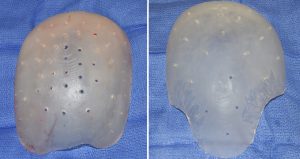Background: Custom skull implants have proven to be a reliable method of treating a wide variety of head shape issues. In their preoperative design considerable thought goes into how to best achieve the patient’s desired outcome. But despite this design effort, no one can accurately predict the outcome and how the patient will perceive their head shape change.
As a result it will occasionally occur that a patient desires to replace their existing skull implant. This may be for a size change (bigger or smaller) or to alter some aspect of its shape or perimeter outline. In doing so patients understandably wonder if their recovery will be as significant as it was during the initial implant placement.
Case Study: This middle aged male had a prior head heightening custom skull implant placed. While he liked the height result, he felt it came a bit too far forward into his forehead. He wanted the front edge of the implant to be moved back to a location and shape of that of his frontal hairline.

How does a custom skull implant get through a small scalp incision? It can because it is deformable. It can be folded to become smaller and then be inserted through the scalp incision. Once inside it is unfolded and positioned.
With an established pocket the exchange of a custom skull implant is substantially easier with a much quicker recovery.
Case Highlights:
1) Patients occasionally decide for a custom skull implant replacement based on their outcome or a change in their aesthetic objectives.
2) In an established pocket a skull implant can be replaced with much less trauma than the first surgery.
3) In a small skull implant in an established larger pocket, screw fixation is essential.
Dr. Barry Eppley




